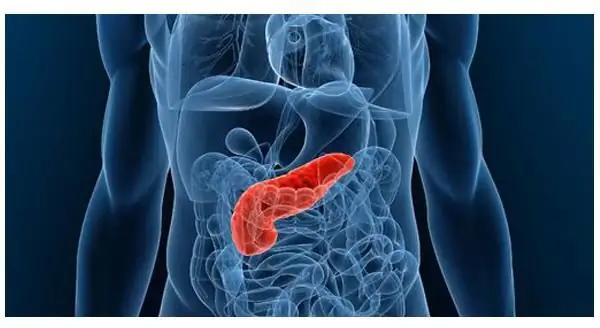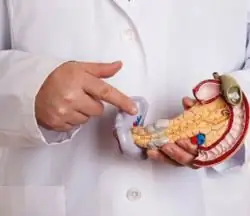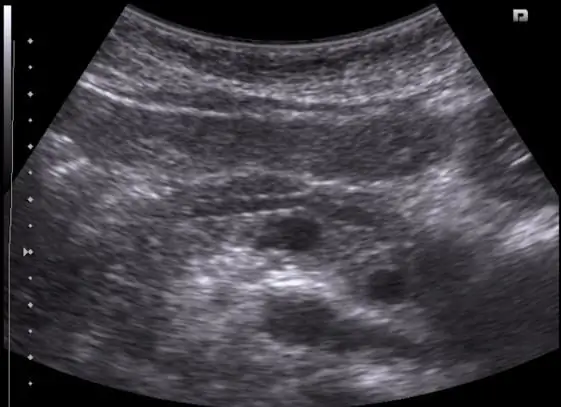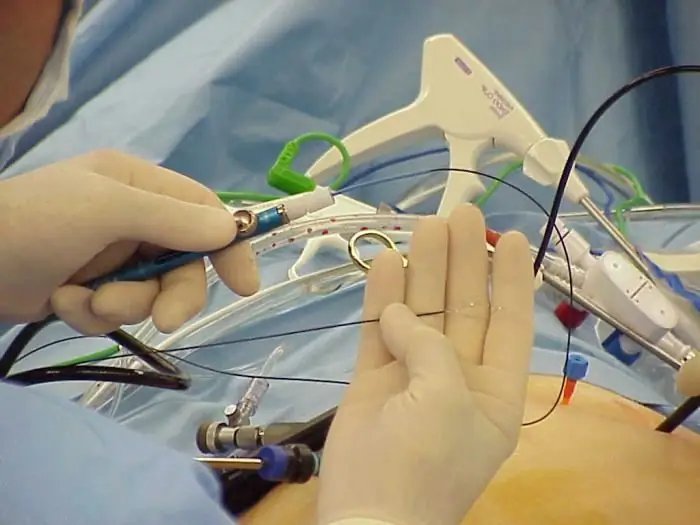- Author Curtis Blomfield [email protected].
- Public 2023-12-16 20:44.
- Last modified 2025-01-23 17:01.
Stones in the pancreas - a pathology, which in medicine is known as "pancreolithiasis". It should be noted that this disease is quite rare. However, no one is immune from its development. That is why today many people are interested in additional information about what are the causes of this disease, what symptoms it manifests.
More about the problem

Stones in the pancreas can have different sizes and shapes. In most cases, such formations are oval, but irregularly shaped calcifications are also common. Most often, such stones are formed in additional ducts or in their branches. On the other hand, the formation of solid structures can be observed in the parenchyma of the pancreas itself.
As for the chemical composition, the main of these stones are phosphate or carbonate calcium s alts. In addition, compounds of aluminum, magnesium, as well as some substances of organic origin may be present in such formations.
Main causes of deposits
To date, scientists have not yet been able to find all the possible causes of the development of such a disease. Temhowever, some risk factors have already been identified:
- Stones in the pancreas are often formed against the background of inflammatory diseases, including duodenitis and cholecystitis. In addition, this pathology is often associated with gallstone disease.
- Risk factors can also include any pathological processes in the abdominal cavity that can impede the outflow of pancreatic juice, including the presence of cysts, tumors, edema, inflammation, etc.
- An important role in the development of this disease is played by hormonal disorders. In particular, the formation of stones is often associated with disorders of the parathyroid glands, which lead to impaired calcium metabolism in the body.
- Changes in the chemical properties of pancreatic secretion due to some infectious diseases. For example, pancreolithiasis often occurs against the background of syphilis.
- Bad habits, including alcohol abuse, smoking, etc.
- Wrong diet.
How are stones formed?

Today, many patients are interested in questions about how exactly a stone is formed in the pancreatic duct. In fact, this process is quite lengthy. First, under the influence of certain factors, the juice secreted by the pancreas becomes more concentrated and gradually thickens. Over time, an insoluble protein mass forms in the lumen of the duct.
In the future, such a protein clot becomes a place of deposition of variousinorganic components, in particular, calcium s alts. As the disease progresses, the chemical composition and, consequently, the physical properties of the clot change. The stone clogs the duct, which leads to the accumulation and stagnation of pancreatic juice - this increases the risk of developing infectious inflammation.
Stones in the pancreas: symptoms
Immediately it should be noted that the clinical picture in this case directly depends on the size of such neoplasms and their location. So what disorders cause pancreatic stones? Symptoms in this case are paroxysmal pains of a different nature. In fact, pain syndrome can occur under the influence of various factors, for example, against the background of stress or nutritional errors.

Pain can be either dull or sharp, colicky. By the way, that is why pancreolithiasis is often confused with cholelithiasis. Quite often, during a painful attack, the patient feels severe nausea, which often ends in vomiting. Some complain of pain in the epigastric region, although it may radiate to the lower back or shoulder blades.
Sometimes calcifications clog the bile ducts, which leads to the development of obstructive jaundice - in patients, yellowness of the skin and mucous membranes can be observed. And bile impurities may be present in vomit.
Stones in the pancreas often lead to disruption of the entire organ, which is accompanied by sharp changes in blood sugar levels. Such disorders, as a rule, disappear with the attack. However, if left untreated, it can lead to the gradual development of diabetes. Complications of pancreolithiasis include inflammation of the pancreas (pancreatitis). In any case, this disease requires careful diagnosis and proper treatment.
Basic diagnostic methods
Unfortunately, today the process of detecting such a disease is often associated with some difficulties, since the clinical picture of pancreolithiasis resembles some other diseases of the gastrointestinal tract.
To begin with, the doctor must collect an anamnesis, familiarize himself with the main complaints of the patient, and also conduct an initial examination. Based on the existing violations, the specialist prescribes further studies. Naturally, the patient is required to provide blood and urine samples. In addition, a laboratory study of feces is extremely important - often there are droplets of fat in the samples, as well as small stones containing calcium s alts. An ultrasound of the abdominal organs is performed.

However, the most informative is the radiography of the abdominal cavity, which allows not only to determine the presence of stones, but also to find out their size, number and location. In the most severe cases, computed tomography or endoscopic examination of the affected organ is performed.
Pancreatic stone: conservative treatment
After establishing an accurate diagnosis, the doctor will prescribe the appropriatedrugs. What therapy does a stone in the pancreas require? Treatment depends primarily on the number and size of stones, as well as on the condition of the patient. In some cases, it is appropriate to use special preparations that dissolve such formations. But such tools can only cope with small stones.
When the body is depleted, patients are prescribed vitamins and glucose. Pain syndrome is relieved with painkillers, and for inflammation, respectively, non-steroidal anti-inflammatory drugs are used.

Can pancreatic stones be eliminated with proper nutrition? Diet is definitely an integral part of the treatment. In particular, spices, spicy foods, fatty and fried foods, simple carbohydrates (sweets), and alcohol should be excluded from the diet.
Surgical therapies
Unfortunately, not in all cases it is possible to solve the problem in conservative ways. For example, the presence of large stones, exhaustion of the body, developing pancreatic insufficiency, or chronic inflammation are indications for surgical intervention.

How are pancreatic stones removed? The operation can be classic - the formations are removed through an incision in the abdominal wall or they are pushed into the lumen of the small intestine. But today, endoscopic procedures are becoming increasingly popular, in which stones are dissolved using a specialapparatus equipped with optical fiber. Such an operation does not require a large incision and is much less likely to be accompanied by complications (such as infection).






